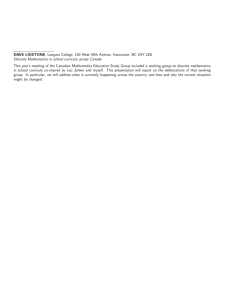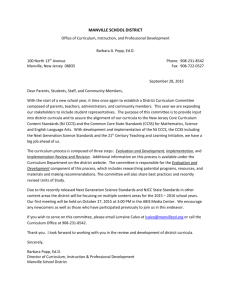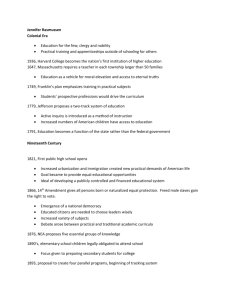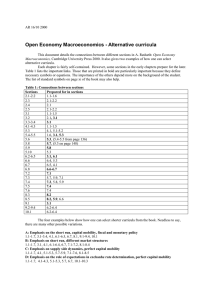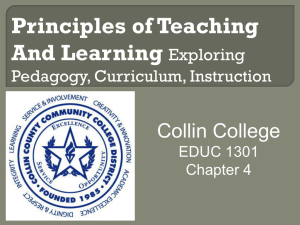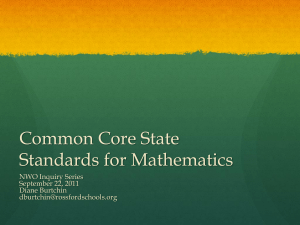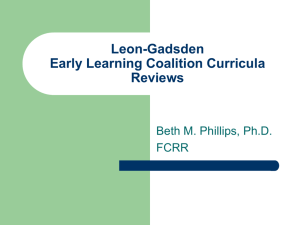A Tool for Reviewing K–12 Financial Education Curricula
advertisement
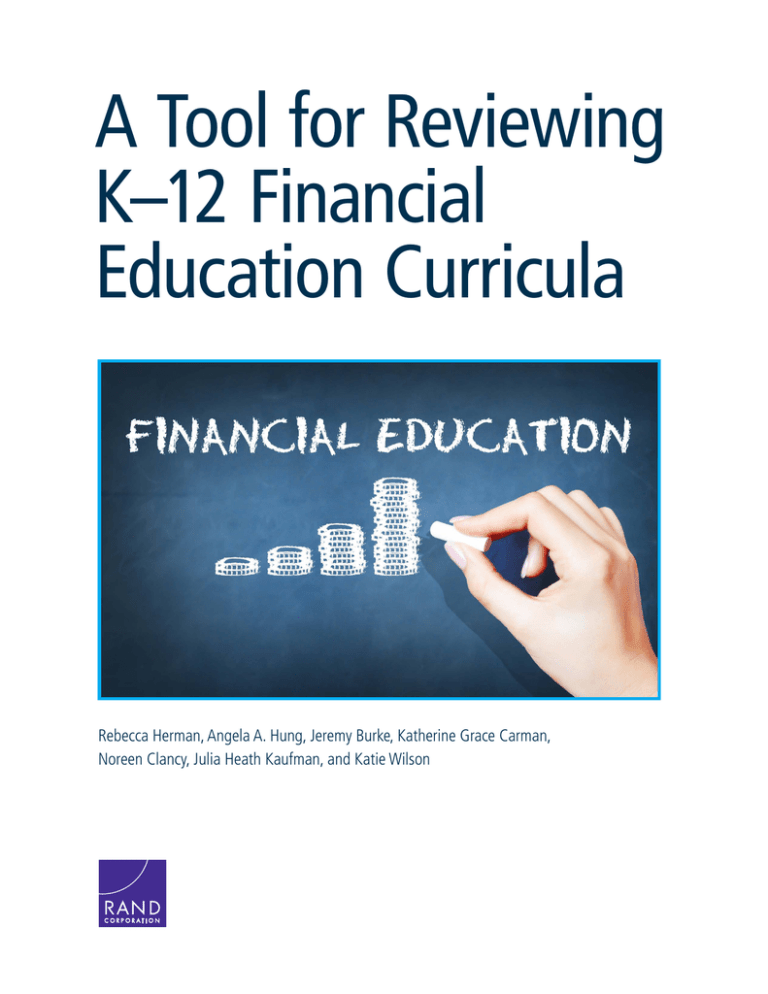
A Tool for Reviewing K–12 Financial Education Curricula Rebecca Herman, Angela A. Hung, Jeremy Burke, Katherine Grace Carman, Noreen Clancy, Julia Heath Kaufman, and Katie Wilson C O R P O R AT I O N For more information on this publication, visit www.rand.org/t/tl181 Library of Congress Cataloging-in-Publication Data is available for this publication Cover and interior pages—All photos: Fotolia. Published by the RAND Corporation, Santa Monica, Calif. © Copyright 2015 RAND Corporation R® is a registered trademark. Limited Print and Electronic Distribution Rights This document and trademark(s) contained herein are protected by law. This representation of RAND intellectual property is provided for noncommercial use only. Unauthorized posting of this publication online is prohibited. Permission is given to duplicate this document for personal use only, as long as it is unaltered and complete. Permission is required from RAND to reproduce, or reuse in another form, any of its research documents for commercial use. For information on reprint and linking permissions, please visit www.rand.org/pubs/permissions.html. The RAND Corporation is a research organization that develops solutions to public policy challenges to help make communities throughout the world safer and more secure, healthier and more prosperous. RAND is nonprofit, nonpartisan, and committed to the public interest. RAND’s publications do not necessarily reflect the opinions of its research clients and sponsors. Support RAND Make a tax-deductible charitable contribution at www.rand.org/giving/contribute www.rand.org ii Contents Introduction. . . . . . . . . . . . . . . . . . . . . . . . . . . . . . . . . . . . . . . . . . . . . . . . . . . . . . . . . . . . . . . . . . . . . . . . 1 Understanding the Big Ideas. . . . . . . . . . . . . . . . . . . . . . . . . . . . . . . . . . . . . . . . . . 3 Alignment of Common Core State Standards with K–12 Financial Education Curricula.. . . . . . . . . . . . . . 11 FIGURES 1. Overview of Key Steps. . . . . . . . . . . . . . . . . . . . . . . . . . . . . . . . . . . . . . . . . . . . . . . 2 2. Four Aspects of Financial Education Curricula.. . . . . 3 3. Level of Detail for Alignment Between CCSS Mathematics and Curricula. . . . . . . . . . . . . . . . . . . . . . . . . . . . . . . . . . . . . . 12 TABLES 1. Reviewing Curriculum Content.. . . . . . . . . . . . . . . . . . . . . . . . . . . . . . . . 5 2. Reviewing Utility.. . . . . . . . . . . . . . . . . . . . . . . . . . . . . . . . . . . . . . . . . . . . . . . . . . . . . . . . . 7 3. Reviewing Quality. . . . . . . . . . . . . . . . . . . . . . . . . . . . . . . . . . . . . . . . . . . . . . . . . . . . . . . 8 4. Reviewing Efficacy.. . . . . . . . . . . . . . . . . . . . . . . . . . . . . . . . . . . . . . . . . . . . . . . . . . . . . . 9 5. Example Alignment Form. . . . . . . . . . . . . . . . . . . . . . . . . . . . . . . . . . . . . . . . 13 6. Example Criterion from the Complete Rubric. . . . . 14 Notes.. . . . . . . . . . . . . . . . . . . . . . . . . . . . . . . . . . . . . . . . . . . . . . . . . . . . . . . . . . . . . . . . . . . . . . . . . . . . . . . . . . 17 About This Tool. . . . . . . . . . . . . . . . . . . . . . . . . . . . . . . . . . . . . . . . . . . . . . . . . . . . . . . . . . . . . . . . 18 iii iv Introduction T oday’s students are expected to be prepared to manage their finances in just a few short years. To help them prepare for this responsibility, states and localities are encouraging financial education instruction in K–12 education. A bewildering array of curricula and materials is available to support K–12 financial education—more than 85 curricula were available as of 2014. To help teachers and education leaders think about which curriculum to use, and to better understand the strengths and gaps in the curriculum currently being used, the RAND Corporation has developed this tool for reviewing financial education curricula. This guide is designed for teachers and others who might need a straightforward tool that can be used without substantial training and time. It is based on a much more detailed review rubric, the Complete Rubric for Reviewing Financial Education Curricula, which can be used when time and resources permit a full and complete review.1 For example, if state education leaders wish to develop a list of financial education curricula to recommend to schools and districts, they might assemble a panel of teachers and researchers to review the existing curricula using the full rubric. Similarly, curriculum providers might want to review their own curricula using the full rubric, to consider areas of strength and areas for further development. Both this tool and the complete rubric in the full companion report draw on extensive reviews of the existing research, as well as analyses of content standards and financial education curricula. Additionally, the tool and report have been informed by expert guidance.2 This guide will take you through the three key steps to reviewing financial education curricula (see Figure 1). You should expect that a typical review will take a day or two, but a review can take up to four or five days, depending on the amount of information and the availability of reviewers. A ­bewildering array of curricula and materials is available to ­support K–12 financial education. To help educators think about which curriculum to use, the RAND ­Corporation has developed this tool for reviewing financial education curricula. 1 Figure 1. Overview of Key Steps STEP 1 Prepare for the review STEP 2 Review the curriculum STEP 3 Use the information from your review A Note on Curriculum This tool is designed to support review of financial education curricula. There are also many noncurricular financial education resources available; this tool is not appropriate for reviewing individual resources. A curriculum generally provides content learning objectives, teaching methods, assignments, materials, and sequence of instruction. The scope of the curriculum may vary, but a curriculum is generally considered to include multiple lessons over multiple days, at minimum. 2 Understanding the Big Ideas This guide focuses on four aspects of financial education curricula: content, utility, quality, and efficacy. Figure 2. Four Aspects of Financial Education Curricula Covers core knowledge and skills Improves financial knowledge, skills, or behaviors Content Efficacy Utility Quality Supports effective teaching Accurate and well presented 3 Step 1: Prepare for the Review Assemble all of the materials that constitute the curriculum. This would likely include the following: • scope and sequence • lesson plans for each lesson, with objectives, activities, supporting materials (such as handout masters), and directions for teachers • student assessments • guidance for teachers, such as suggestions for tailoring lessons, additional resources, and glossaries. These materials may be provided in several formats and packages. For example, some materials may be online, some may be on a DVD or flash drive, and some may be on paper. You are likely to find that you will have, at minimum, a teacher workbook and a student workbook. Also assemble research on the effects of the curriculum. Aim to collect carefully conducted, objective, independent studies. You can get much of this quickly by (1) searching on the curriculum name and “effects,” “impact,” or “evaluation” using an online search engine (such as Google Scholar) and (2) looking at the curriculum provider’s website. You might be able to find already-reviewed studies in the What Works Clearinghouse; search for “quick reviews” and “single study review.”3 Financial education is not a focus topic for the What Works Clearinghouse, but if it does review a study on financial education curricula, you can trust that review. Step 2: Review the Curriculum Step 2A: Start by reviewing content. Read through the scope and sequence, and skim the lesson plans. Using Table 1, indicate which topics (first column) are covered somewhere in the curriculum materials. You can use the information in the middle column (pick the section that matches your school level) to help you think about how to answer the question. If most or all of the examples in the middle column for your school level are addressed (you can circle the subtopics that are addressed), mark “yes.” Otherwise, mark “no.” The complete rubric (Herman et al., 2015, Appendix A) includes more detail on these subtopics. Ideally, you want a curriculum that covers most subtopics in each of the six topics. 4 Table 1. Reviewing Curriculum Content DOES THE CURRICULUM COVER THIS TOPIC? a Earning, income, and careers FOR EXAMPLE . . . Elementary School Sources of income; changing income through education, work, and skills ANSWER • Yes • No Middle School Sources of income; changing income through education, work, and skills; labor market changes High School Employee benefits; changing income through education, work, and skills; entrepreneurs; taxes Saving and investing Elementary School Different reasons for saving; interest; investments and risk • Yes • No Middle School Different reasons for saving; interest and inflation; investments and risk High School Different reasons for saving; employee benefit programs; interest and inflation; investments and risk Spending Elementary School Making spending choices; being an informed consumer • Yes • No Middle School Making buying choices; being an informed consumer; budgeting High School Making buying choices; being an informed consumer; fraud Borrowing and credit Elementary School Understanding credit; interest • Yes • No Middle School Long-term investments; interest rates for loans; credit sources; unpaid credit card balances; credit risk and history High School Long-term investments; costs of credit options; consumer protection; student loans; credit risk and history; debt options Managing risk Elementary School Understanding what risk is; individual choices about risk • Yes • No Middle School Risk avoidance; types of insurance; how insurance premiums relate to individual behavior High School Risk avoidance; types of insurance; how insurance premiums relate to individual behavior 5 Table 1—Continued DOES THE CURRICULUM COVER THIS TOPIC? a FOR EXAMPLE . . . Financial responsibility, Elementary School money management, and Planning for the future financial decisions Middle School Planning for the future ANSWER • Yes • No High School Planning for the future; financial advice a These topics are based on analysis of existing financial education content standards used at the national and state levels. Step 2B: Next, review utility to determine whether the curriculum provides sufficient guidance and support for a teacher to be able to teach the curriculum effectively. Read through the lesson plans and supporting materials thoroughly. If there are a lot of lesson plans (more than four or five), you might review four or five closely to make sure you understand the kinds of information included in the lesson plans, then just skim the rest to make sure they provide the same kinds of information. Using Table 2, indicate whether the curriculum materials address important aspects of curriculum utility. You can use the information in the middle column to help you think about how to answer the question. If most or all of the example questions in the middle column can be answered “yes,” mark “yes” in the right column. Otherwise, mark “no.” The complete rubric (Herman et al., 2015, Appendix A) includes more detail on these questions. Ideally, you want a curriculum that covers all five aspects of utility to some extent. 6 Table 2. Reviewing Utility DO THE CURRICULUM MATERIALS . . . FOR EXAMPLE . . . ANSWER Support students’ cognitive development? • Do activities develop students’ knowledge of procedures (e.g., how to calculate interest or the definition of mortgage), conceptual understanding of big ideas (such as being an informed consumer), and how to apply what they have learned in a real-life context (such as making budgets for themselves)? • Do activities require higher-order thinking skills and build students’ understanding of how they learn? • Do lessons cover specialized vocabulary? • Yes • No Help the teacher differentiate instruction? • Do the materials show how to recognize students’ needs (such as struggling or advanced students, students with disabilities, students with different exposure to financial concepts) and how to tailor instruction? • Do the activities connect to students’ lives and experiences and involve hands-on learning? • Yes • No Help teachers plan and carry out instruction? • Are the materials well organized with objectives, lesson plans, materials to support activities, assessments, teacher notes, and additional resources? • Is the content logically sequenced to build over time? • Are the materials aligned with other requirements for teachers, such as state standards or Common Core State Standards (CCSS)?a • Yes • No Include useful assessments? • Are there formative assessments of progress and summative assessments of cumulative learning? • Do assessments test financial knowledge, skills, understanding, and application? • Are assessments free of obvious bias? • Yes • No Help teachers unfamiliar with financial education get a firm grounding? • Are there such tools as glossaries, teacher notes, and links to additional resources? • Are the main ideas clearly identified? • Yes • No a This question calls for judgment and some familiarity with CCSS on the part of the reviewer. If alignment with CCSS is a priority and the review needs more guidance, please see the section on Alignment of Common Core State Standards with K–12 Financial Education Curricula on p. 11. 7 Step 2C: Next, review quality to determine whether the information and materials in the curricula are accurate, unbiased, and well presented. To review quality, you should be familiar with the lesson plans and supporting materials, which you read when reviewing utility in Step 2B. If some time has passed, you will likely want to refresh your memory. Using Table 3, indicate whether the curriculum materials address important aspects of curriculum quality. You can use the information in the middle column to help you think about how to answer the question. If all of the example questions in the middle column can be answered “yes,” mark “yes” in the right column. Otherwise, mark “no.” The complete rubric (Herman et al., 2015, Appendix A) includes more guidance on these questions. Ideally, you want a curriculum that covers all four aspects of quality to some extent. Table 3. Reviewing Quality ARE THE CURRICULUM MATERIALS . . . 8 FOR EXAMPLE . . . ANSWER Easy to get to? • Do web links lead to the right place, and are paper-based materials affordable? • Is it clear (and reasonably flexible) what you can copy and reuse? • Yes • No Current and error free? • Have the materials been updated in the past three years? • Are the materials free of errors in fact, spelling, punctuation, etc.? • Yes • No Objective? • Do the materials differentiate between fact and interpretation and provide differing views on the latter? • Do pictures show diversity, and are materials culturally sensitive? • Does the curriculum avoid promoting branded products? • Yes • No Displayed in a manner that supports learning? • Are the visuals informative and relevant? • Is the formatting clear and easy to read? • Yes • No Step 2D: Finally, review curricula efficacy to determine whether there is strong evidence to demonstrate the positive effects on students’ financial knowledge, skills, and behaviors. To review efficacy, start by familiarizing yourself with the studies about the impact of the curriculum on students. The following sections should be read especially closely: • Citation: Was the study recent? • Abstract: Which curriculum was reviewed? How was the study designed? What were the findings? • Study design: Was there a comparison group? How were outcomes measured? (This might also be in the sample and measures sections.) • Results: What were the findings? First, look at each study. Then, look across all of the studies that are carefully conducted, objective, and independent. Using Table 4, indicate whether strong research and evidence are available to demonstrate that the curriculum has had positive effects on students. You can use the information in the middle column to help you think about how to answer the question. If all of the example questions in the middle column can be answered “yes,” mark “yes” in the right column. Otherwise, mark “no.” The complete rubric (Herman et al., 2015, Appendix A) includes more guidance on these questions. A curriculum with high efficacy is one with multiple, strong studies consistently showing positive effects. Note that this step may be difficult to do on your own if you do not have a strong research background and if you have limited time to read and analyze research studies. If you are interested in assessing efficacy more fully, you may want to consider collaborating with someone with a research background. Table 4. Reviewing Efficacy FOR THE CURRICULUM . . . FOR EXAMPLE . . . ANSWER Is there at least one strong study? • Is there at least one study of the effects of the curriculum on students? • Does the study compare students who use the curriculum to those who do not, and does it describe the experiences of each group of students? • Does the study look at important financial knowledge, attitudes, or behaviors as outcomes? Is the study recent (within the past ten years)? • Yes • No Do multiple strong ­studies consistently show positive effects? • Is there more than one study of reasonable quality? • Are the findings consistent across studies and strong (e.g., statistically significant)? • Yes • No 9 Step 3: Use the Information from Your Review Depending on your reason for conducting this review, you can use the information in several ways. If you looked at only one curriculum, consider whether the review shows that the curriculum is strong on most or all of the dimensions. If not, consider whether you have additional resources, such as time and funding, to supplement the curriculum where there are gaps. If you and your colleagues are selecting a financial education curriculum for use in your class or school, and if you have reviewed several curricula, identify the curriculum that emerged as strongest across dimensions. Does it cover important content? Is it designed to be easy to use, and is it of high quality? Findings of effectiveness would be especially powerful, but at the time of this writing, very few curricula have been examined in strong studies, so this should not be the only factor to consider. Consider your context, also. If the teachers who will be teaching financial education have experience or training in this area, you may not need a curriculum with substantial guidance for teachers. If the financial education teachers do not have strong expertise or training in this area, however, you may need a curriculum with substantial guidance for teachers. If your school incorporates financial education in an existing course, you may need a curriculum designed to be delivered over fewer lessons. If you looked at only one curriculum, consider whether the review shows that the curriculum is strong on most or all of the dimensions (e.g., got mostly “yes” responses in the review). If not, consider whether you have additional resources, such as time and funding, to supplement the curriculum where there are gaps. If you do not have additional resources, consider looking at a different curriculum. If you and your colleagues are reviewing a curriculum already in place in your school, the information from your review can guide your use of the curriculum. If you identified gaps, consider where you can tap additional resources to address the gaps. If the curriculum contains too much content to cover in the time you have, you can use the review to guide your thinking on how to prioritize topics or activities. Learning More If you would like to learn more about the content and underlying research for this tool, you can explore the full rubric in Appendix A in the companion report (Herman et al., 2015). If you would like to access additional resources about financial education, please visit the Consumer Finance Protection Bureau website.4 10 Alignment of K–12 Financial Education Curricula with Common Core State Standards This section summarizes recommendations for examining the alignment of K–12 financial education curricula with CCSS. These recommendations build on the M ­ aterials Alignment Toolkit for evaluating alignment of instructional and assessment materials with the CCSS.5 Within the toolkit, we focused on the Instructional Materials Evaluation Tool (IMET), which was designed for evaluating alignment of mathematics and English-language arts (ELA) curricula with the CCSS; mathematics and ELA have separate IMETs. We drew heavily on guidance from Julia Heath, director of the ­Economics Center at the University of Cincinnati and the president of the Ohio Council on Economic Education, and Judy Wurtzel, senior advisor to the Noyce Foundation and past advisor for the President’s Advisory Council on Financial Capability. The relationship between mathematics and financial education is somewhat different from the relationship between ELA and financial education. Mathematics topics (e.g., the number system and base 10, probability) are directly relevant to financial education topics (e.g., understanding money, computing interest). For ELA, however, the point of overlap is not content (e.g., Shakespeare) but the complexity and quality of the reading materials and the approaches to questioning, writing, speaking, and listening embedded in the curriculum and standards. Therefore, we suggest different approaches for considering alignment between CCSS mathematics and financial education curricula from those for considering alignment between CCSS ELA and financial education curricula. 11 Aligning with CCSS Mathematics Grain Size To operationalize the alignment process, one must determine the grain size of the items to align. The more detailed the item being aligned, the less the person doing the alignment needs to interpret and guess at the nature of the item. However, aligning very detailed items can be extraordinarily time-­consuming and, more importantly, subvert the focus from important big ideas to overly focused examples. In the CCSS for mathematics, there are domains (e.g., Numbers and Operations in Base 10). For each domain, there are grade-specific clusters (e.g., use place value understanding and properties of operations to perform multidigit arithmetic). There are just under 150 clusters in CCSS mathematics. Within each of these clusters, there are grade-specific standards (e.g., use place value understanding to round whole numbers to the nearest 10 or 100). The curriculum also can be examined at different levels. You could look at the list of topics, as presented in the scope and sequence; you could review lesson plans; or you could look at each activity within lesson plans. See Figure 3 for a graphic representation of the organization of CCSS mathematics (left triangle), typical curriculum organization (right triangle), and the recommended level of detail at which to carry out alignment exercises. Figure 3. Level of Detail for Alignment Between CCSS Mathematics and Curricula Domains Grade-specific clusters Grade-specific standards CCSS mathematics 12 Topics Alignment Greater detail Lesson plans Activities Curriculum For aligning financial education curricula with CCSS mathematics, based on the guidance of Heath and Wurtzel, we recommend focusing on the grade-specific clusters of standards for CCSS mathematics, which provide sufficient grade-level specificity without being overly narrow. For the curriculum, the corresponding level of detail to consider is the content of the lesson plans. The materials that comprise the lesson plans provide sufficient detail to make a judgment as to whether the curriculum aligns with the CCSS. Alignment Approach There are a number of ways to operationalize curriculum alignment. Heath and Wurtzel both recommend focusing on the proportion of the curriculum that is aligned with the CCSS content. IMET provides a process for measuring proportional alignment for mathematics curricula. The following steps draw on the IMET process, modified as appropriate for financial education curricula (see Table 5 for a partial example form): • Prioritize CCSS standards clusters for each school level; that is, identify the clusters that are most important for financial education curricula. Note that IMET focuses on grade level, but we recommend collapsing grade levels into school levels to correspond to the design of most financial education curricula: elementary school = grades K–5; middle school = grades 6–8; and high school = grades 9–12. An alternative approach is to break elementary school into early (K–2) and late (3–5), as some financial education curricula do. • Drawing on curriculum description materials, quantify the duration of the curriculum (e.g., is it meant to occur over 40 hours? 15 lessons?). Quantify the duration of each lesson plan. Note that IMET suggests using days as the quantity. However, days may be less meaningful for Table 5. Example Alignment Form SCHOOL LEVEL PRIORITIZED CLUSTER LESSON PLAN TIME SPENT ON LESSON PLAN % OF TOTAL TIME SPENT ON CLUSTER Elementary school K.CC.Ba Understanding Money 45 minutes 45 minutes / 450 minutes = 10% K.OC.A … … … Middle school … … … … High school … … … … a Using this cell as an example, each CCSS standard cluster is referenced by the grade level (here, K for kindergarten), abbreviation for the domain (here, CC for Counting and Cardinality), and standards cluster (here, “B” for the second listed standards cluster under CC). 13 financial education curricula, which can last for several weeks to a semester, than for mathematics curricula, which tend to cover a semester or year. Therefore, we leave the unit to the discretion of the reviewing organization. • For each prioritized CCSS standards cluster, record which lesson plans address that cluster; each lesson plan may align with only one standards cluster. Then record the amount of time spent on that lesson plan. • Compute the percentage of total curriculum time (time on prioritized standards cluster divided by time for entire curriculum). • Sum the percentage of time spent on prioritized CCSS standards clusters, within school levels. • Use modified IMET decision rules to judge degree of alignment: For a curriculum to be aligned with the CCSS, materials should devote at least 65 percent and up to approximately 85 percent of class time to the major work of each school level. Each level must meet the criterion; do not average across two or more levels.6 IMET also provides guidance on evaluating alignment in focus (addressing topics at the CCSS-prescribed grade levels), rigor and balance (balancing conceptual understanding, procedural skill and fluency, and application), and connecting practice and content, as well as additional criteria and indicators of quality (e.g., coherence, lesson structure). Most of these criteria are addressed in the full companion report (Herman et al., 2015). For example, Table 6 depicts Utility 1.1, which addresses rigor and balance. Table 6. Example Criterion from the Complete Rubric INDICATOR 1.1: Materials include a balanced focus on concepts (e.g., being an informed consumer), procedures (e.g., knowing how to calculate interest or the definition of mortgage), and application (e.g., making a budget). REQUIRED OR RECOMMENDED a Required QUESTION Are there multiple activities for each of the following: –– Procedural learning: memorizing content or practicing processes accurately and quickly –– Conceptual learning: describing underlying ideas in written and spoken activities –– Application: independently using knowledge and skills in simulated or real situations, choosing a strategy to solve problems with persistence? • Yes • No SOURCE: Herman et al., 2015. a Each question is identified as “required” or “recommended.” All required questions must be answered “yes” for a criterion to be rated highly. Recommended questions contribute to the rating. For further explanation, see Herman et al., 2015, Appendix A. 14 As noted, we recommend focusing on the percentage of time the curriculum addresses core CCSS mathematics topics. If the user would also like to evaluate alignment with these additional criteria, we recommend identifying the relevant items in the rubric and summarizing the ratings on those items rather than conducting the full IMET review. Aligning with CCSS English-Language Arts For ELA, CCSS sets standards for reading, writing, speaking and listening, and language in ELA classes. Across these ELA skill sets, there is emphasis on complexity and quality of the reading materials and on approaches to questioning, writing, speaking, and listening embedded in the curriculum and standards. Some of these criteria are addressed in the rubric (Herman et al., 2015, Appendix A), but not all, and not as deeply as in IMET. For example, the Utility 2.1 in the rubric asks “Is the text appropriate for the student’s grade level?” IMET specifies that “Texts in all grades must be accompanied by specific evidence that they have been analyzed for their qualitative features and/or instructional value justifying and indicating a specific grade-level placement” (IMET for CCSS Alignment in ELA/Literacy, Grades K–2, p. 3) and provides names of tools that can be used to measure text complexity (Section IV of IMET). Rather than replicate this work, we recommend that IMET be used to evaluate alignment of financial education curricula with CCSS ELA, with the following revisions: • Omit the criteria on foundational skills, which focus on learning to read (Non-Negotiable 1 in grades K–2, Non-Negotiable 6 in grades 3–5). • Omit the criteria on language, which focus on grammar and language conventions (Non-Negotiable 9). • Change references of “grade level” to “school level,” consistent with the focus of financial education curricula. • Revise specific language as appropriate for working with financial education curricula. For a more manageable but less systematic approach to aligning curricula with CCSS ELA, a review might use just the rubric items that correspond to IMET items (e.g., Utility 2.1). 15 Scoping an Alignment Review Alignment reviews generally are staffed by approximately three teachers who teach the relevant subject matter; the group may include a curriculum director. It is possible to do an alignment activity with a single reviewer; however, multiple reviewers provide different perspectives and can reduce reviewer bias. Regardless of the number or experience of the reviewers, they should be trained to use the alignment instrument. The review process typically includes these steps for the reviewer(s): • Read through the curriculum materials and complete the alignment instrument independently. • Meet with other reviewers to discuss ratings and resolve discrepancies. • Record the final ratings and discussion. This process may take approximately one week of labor per person per curriculum. 16 Notes The review rubric can be found in Appendix A of the companion report to this tool. See Rebecca Herman, Angela A. Hung, Jeremy Burke, Katherine Grace Carman, ­Noreen Clancy, Julia Heath Kaufman, and Katie Wilson, Development of a K–12 Financial Education Curriculum Assessment Rubric, Santa Monica, Calif.: RAND ­Corporation, RR-1142-CFPB, 2015. As of June 1, 2015: http://www.rand.org/pubs/research_reports/RR1142.html 1 The literature reviewed and expert guidance are documented in the full report (­Herman et al., 2015). 2 See What Works Clearinghouse, home page, undated. As of May 15, 2015: http://ies.ed.gov/ncee/wwc/ 3 Consumer Finance Protection Bureau, home page, undated. As of May 15, 2015: http://www.consumerfinance.gov 4 Achieve the Core, Student Assessment Partners, and the Council of Chief State School Officers, Materials Alignment Toolkit, August 23, 2013. As of August 11, 2014: http://achievethecore.org/dashboard/7/search/1/1/0/1/2/3/4/5/6/7/8/9/ 10/11/12/page/285/materials-alignment-toolkit-list-pg 5 See the IMET for CCSS Alignment in Mathematics, Grades K–8, p. 3, available on the website for the Materials Alignment Toolkit. 6 17 About This Tool Financial education during elementary and secondary school years can provide a solid foundation of skills and knowledge that students will need for financial decisionmaking later in life. There are numerous financial education materials targeted at K–12 students. However, little exists in the way of guidelines or criteria that would allow educators to assess the content, utility, quality, and efficacy of these curricula. The Office of Financial Empowerment at the Consumer Financial Protection Bureau contracted with RAND to develop criteria that can be used to assess K–12 financial education curricula. This tool advances a set of criteria—based on a literature review and discussions with financial curriculum experts, teachers, and financial education curriculum developers—for assessing financial education curricula on multiple dimensions. This tool will be of interest to school and district staff, to support their reviews of financial education curricula. A companion report, Development of a K–12 Financial Education Curriculum Assessment Rubric, describes the research design and findings. For more information on that publication, visit http://www.rand.org/pubs/research_reports/RR1142.html. This research was sponsored by the Consumer Finance Protection Bureau and conducted within the RAND Labor and Population Center for Financial and Economic Decision Making, as well as RAND Education. For more information on the RAND Center for Financial and Economic Decision Making, see http://www.rand.org/labor/centers/cfed.html or contact the director, Angela Hung, at Angela_Hung@rand.org. More information about RAND is available at www.rand.org. 18
